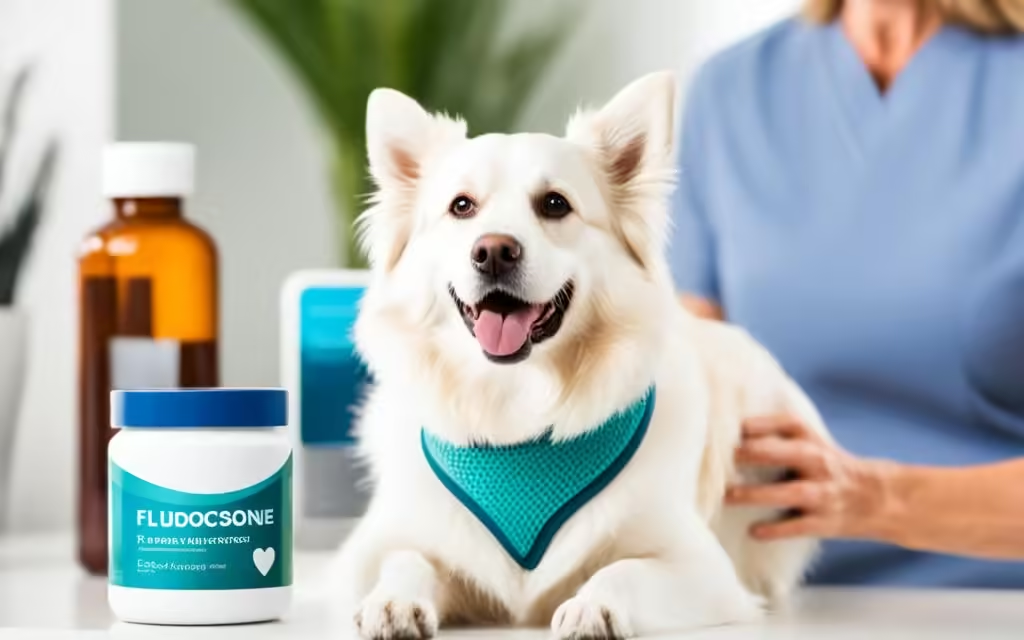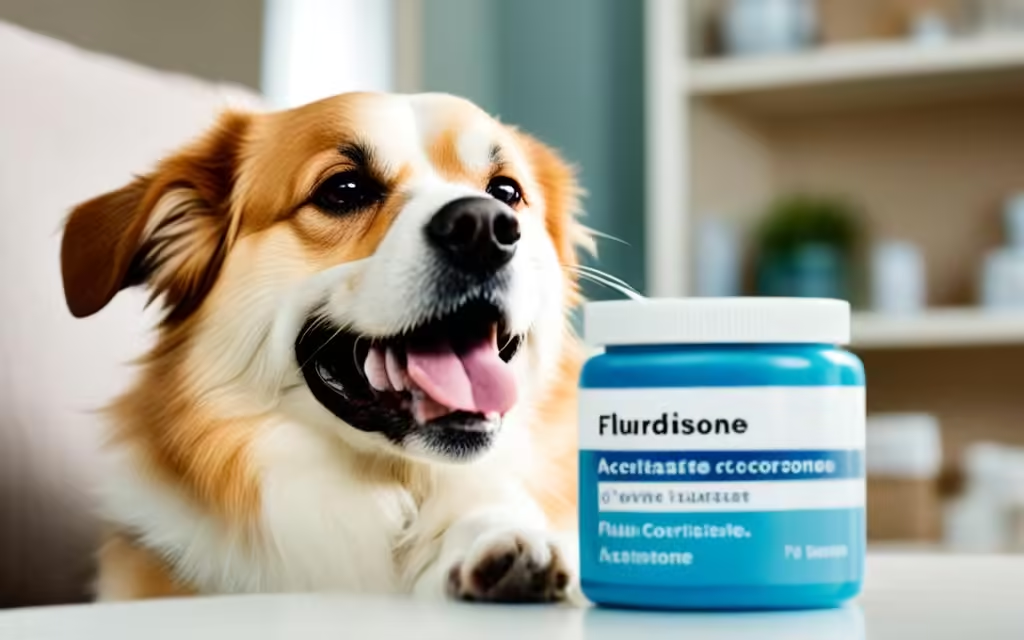Fludrocortisone Acetate for Dogs: Uses and Benefits
Fludrocortisone acetate is a key medicine for dogs with Addison’s disease, also known as hypoadrenocorticism1. It’s a synthetic corticosteroid that helps keep the balance of sodium and potassium in a dog’s body. This medicine, sold as Florinef, comes in 0.1 mg tablets. It’s vital for dogs with adrenal insufficiency, supporting their health and wellbeing over time.
Key Takeaways
- Fludrocortisone acetate is a synthetic corticosteroid medication used to treat Addison’s disease (hypoadrenocorticism) in dogs.
- It acts as a mineralocorticoid, similar to the natural hormone aldosterone, to help maintain the balance of sodium and potassium in the body.
- Fludrocortisone acetate is commonly sold under the brand name Florinef and is available in 0.1 mg tablets.
- It is an important treatment option for dogs with adrenal insufficiency, providing essential hormone replacement therapy.
- Fludrocortisone acetate helps support the long-term health and wellbeing of dogs with Addison’s disease.
Table of Contents
What is Fludrocortisone Acetate?
Fludrocortisone acetate is a synthetic corticosteroid used to treat Addison’s disease in dogs and other pets2. It’s sold as Florinef or generic forms. This medicine acts like the hormone aldosterone, which the adrenal glands make naturally3.
Brand Names and Generic Forms
Fludrocortisone acetate is mostly known as Florinef, made by Bristol-Myers Squibb3. There are also cheaper generic versions for pet owners3.
Drug Classification and Mechanism of Action
This drug is a synthetic mineralocorticoid. It helps balance sodium and potassium in the body, vital for dogs with adrenal insufficiency2. It works by making the kidneys absorb more sodium and get rid of more potassium. This fixes the electrolyte imbalance of Addison’s disease2.
Fludrocortisone acetate is often used in vet medicine for pets with mineralocorticoid deficiency4. It’s key for treating Addison’s disease in cats, dogs, and ferrets. It keeps the body’s electrolytes in balance and is crucial for pets with adrenal gland issues2.
“Fludrocortisone acetate is a synthetic mineralocorticoid that mimics the action of the natural hormone aldosterone, which is produced by the adrenal glands.”
Fludrocortisone Acetate for dog
Indications for Use in Canine Patients
Fludrocortisone acetate is mainly used to treat Addison’s disease in dogs5. This condition happens when the adrenal glands don’t make enough cortisol and aldosterone. This leads to an imbalance of electrolytes and symptoms5. The drug helps balance sodium and potassium levels, managing the disease’s symptoms5.
This drug is stronger than other adrenal supplements5. It’s not approved by the FDA for pets but is made by special pharmacies5. Dogs with this disease might have an Addisonian crisis, a serious emergency. Fludrocortisone acetate is key in treating this5.
| Key Facts about Fludrocortisone Acetate for Dogs |
|---|
| Used to treat Addison’s disease (hypoadrenocorticism) in dogs5 Acts as a replacement for glucocorticoid and mineralocorticoid hormones5 Stronger for mineralocorticoid replacement than other adrenal supplements5 Not FDA-approved for veterinary use, typically compounded by specialty pharmacies5 Can help manage Addisonian crises, a severe medical emergency5 |

Fludrocortisone acetate is effective for Addison’s disease in dogs but has side effects5. These side effects include more thirst and changes in how often they pee5. Dogs with low adrenal function might need more corticosteroids before surgery or during stressful times5. It’s important to keep an eye on electrolytes and kidney function while using this drug5.
“Fludrocortisone acetate can be a crucial part of the treatment for dogs experiencing Addisonian crises, a severe medical emergency caused by adrenal insufficiency.”
Puppies or kittens of animals on this drug might need milk replacement because it’s in their mom’s milk5. It can also interact with certain medicines like amphotericin B, diuretics, and aspirin5. If you think your dog has taken too much, call your vet or a poison control center5.
Fludrocortisone acetate is crucial for managing Addison’s disease and other adrenal issues in dogs5. But, it’s important to work with a vet to get the right dosage and watch for side effects or interactions5.
Benefits of Fludrocortisone for Dogs
Fludrocortisone acetate is key in managing Addison’s disease in dogs, a serious condition caused by adrenal insufficiency6. It helps replace missing mineralocorticoid activity. This is vital for keeping electrolytes like sodium and potassium in balance7. This balance is essential for normal body function7.
It also eases symptoms like lethargy, weakness, vomiting, diarrhea, and electrolyte issues8.
Fludrocortisone acetate offers long-term hormone replacement therapy. This lets dogs with Addison’s disease live healthy, active lives6. It’s easy to give and only needs to be given once a day6. Plus, it helps balance sodium and potassium levels in the body6.
But, it’s important to know that fludrocortisone can have side effects like insomnia, nausea, vomiting, and changes in diabetes control6. Don’t stop giving it suddenly. Always reduce the dose slowly6.
Overall, fludrocortisone acetate is a key part in managing Addison’s disease in dogs. It provides mineralocorticoid replacement therapy. This helps restore electrolyte balance and improves life quality for dogs with this condition7.
“Fludrocortisone is a game-changer for dogs with Addison’s disease, giving them a new lease on life and allowing them to thrive with proper management of their condition.”
Administering Fludrocortisone to Dogs
Fludrocortisone acetate is a key treatment for dogs with Addison’s disease, also known as hypoadrenocorticism1. It’s given orally, usually once a day or split into two doses1. The exact dose depends on the dog’s needs and how severe their condition is, typically between 0.01 to 0.08 mg/kg daily1.
Dosage Guidelines and Frequency
It’s important to follow your vet’s advice when giving fludrocortisone to your dog1. Give the medicine with food to lessen stomach upset, and catch up on any missed doses without doubling up1.
Proper Administration Techniques
Here’s how to give fludrocortisone to dogs right:
- Use a precise measuring tool, like a syringe or dosing spoon, for the right amount1.
- Blend the medicine with a bit of food or a treat your dog likes9.
- Give the dose at the same time every day, as your vet says, for steady blood levels9.
- Watch how your dog reacts to the medicine and talk to your vet about any changes9.
By sticking to these steps and working with your vet, you can help manage your dog’s Addison’s disease and give them their fludrocortisone correctly9.

Potential Side Effects and Precautions
Fludrocortisone acetate is usually safe for dogs10. It’s a type of corticosteroid used to manage sodium and fluids in the body. It’s mainly given for Addison’s disease and when dogs lose too much sodium in their urine10. Dogs might experience stomach issues, vomiting, headaches, dizziness, and trouble sleeping10. They could also feel restless, depressed, anxious, or have acne and easy bruising10. Serious problems like skin rash, swelling, vision issues, muscle weakness, and black stool need quick medical help10.
Common Adverse Reactions in Dogs
11 Dogs taking Fludrocortisone Acetate might have stomach pain, nausea, and headaches11. They could feel dizzy, have trouble sleeping, and their mood might change11. They might also get acne, have dry skin, bruise easily, and heal slower11. Serious issues include sudden vision loss, heart racing, shortness of breath, and muscle weakness11.
Special Considerations for Breeding, Pregnancy, and Lactation
12 Using corticosteroids for a long time can slow down a child’s growth12. Older adults may feel more sensitive to fludrocortisone, leading to water retention, bone loss, and stomach problems12. Pregnant women might have babies with low hormone levels, causing nausea, diarrhea, or weakness12. Breastfeeding moms should talk to their doctor before using this drug, as it can affect the baby12.
Watch your pets closely for any side effects and tell your vet right away. Keep the medicine in a cool, dry place, out of children’s reach10. Dispose of unused medicine safely to prevent pets or people from taking it by mistake10. If your pet overdoses, call the poison control helpline at 1-800-222-1222 or get emergency help if they have trouble breathing or pass out10.
Drug Interactions and Contraindications
Vets must be careful when giving fludrocortisone acetate to dogs. It can interact with many other medicines11. This includes aspirin, diuretics, digoxin, birth control pills, insulin, and steroids11. It’s important to work closely with the vet to use fludrocortisone safely and effectively.
Also, fludrocortisone isn’t good for dogs with serious infections. It can weaken their immune system11. During pregnancy, it should be used carefully to protect the newborn11.
| Medication | Potential Interaction with Fludrocortisone |
|---|---|
| Phenobarbital | May reduce the effectiveness of fludrocortisone |
| Furosemide | May increase the risk of low potassium levels |
| Insulin or Glipizide | May alter the dosage requirements for these medications |
| Phenytoin | May reduce the effectiveness of fludrocortisone |
| Digoxin | May increase the risk of heart rhythm abnormalities |
| Warfarin | May alter the anticoagulant effect |
| Aspirin | May increase the risk of side effects |
Tell the vet about all medicines your dog is taking, including things you buy over the counter or herbal supplements11. Keeping the vet informed and watching your dog closely is key to using fludrocortisone safely11.
“Fludrocortisone is mainly used for partial replacement therapy in Addison’s disease and salt-losing adrenogenital syndrome.”13
Even though fludrocortisone isn’t FDA-approved for pets, vets often use it for Addison’s disease and hyperkalemia in dogs13. You might need to adjust the dosage and watch your dog closely if they’re taking other medicines13.
Working closely with your vet is crucial for using fludrocortisone safely and effectively in dogs11. Knowing about possible drug interactions and things not to do can help your dog get the best care111314.
Monitoring and Adjusting Treatment
It’s key to keep a close eye on dogs with Addison’s disease, also known as hypoadrenocorticism15. Regular blood tests are needed to check levels of electrolytes like sodium and potassium16. These tests make sure the treatment keeps the right balance. Also, regular vet check-ups are a must to see how the dog is doing, spot any side effects, and adjust the treatment as needed15.
Routine Blood Tests and Veterinary Exams
For dogs on fludrocortisone, regular blood tests and vet visits are a must. These help catch any changes in electrolyte levels, like too much potassium or not enough sodium, which are common in Addison’s disease1516. The vet will also look for other health issues, such as low blood sugar, kidney problems, and anemia15.
Along with blood tests, the vet will check the dog’s overall health during physical exams15. They’ll look at the dog’s energy, appetite, and how they exercise. They’ll also watch for signs of stomach problems like vomiting or diarrhea15.
| Test | Purpose | Interpretation |
|---|---|---|
| ACTH Stimulation Test | Confirm hypoadrenocorticism diagnosis | Post-ACTH cortisol levels ≤2 μg/dL confirm the diagnosis16 |
| Serum Electrolytes (Na+, K+) | Monitor electrolyte balance | Na+:K+ ratio 2 |
| Complete Blood Count | Evaluate overall health | Lymphocyte count >750/mcL may be present15 |
If the tests and exams show the dog needs it, the vet may change the fludrocortisone dose over time1517. This ensures the dog stays healthy with Addison’s disease.
“Ongoing monitoring and potential adjustments to the fludrocortisone acetate treatment plan are essential for dogs with Addison’s disease.”
By keeping a close watch on dogs on fludrocortisone and adjusting the dose as needed, vets can help them stay healthy and balanced151617.
Fludrocortisone vs. Other Adrenal Supplements
Fludrocortisone acetate is a common treatment for Addison’s disease in dogs. But, it’s not the only option. Desoxycorticosterone pivalate (DOCP) injections are also used to manage this condition18. Studies show both can help control the symptoms of Addison’s disease in dogs19.
The cost of treatment can differ. Fludrocortisone is usually cheaper than DOCP injections. The vet will choose the best supplement based on the dog’s needs and health.
Comparative Efficacy and Cost Analysis
Fludrocortisone and DOCP both manage Addison’s disease in dogs well19. But, there are differences. Fludrocortisone is more affordable for pet owners18. DOCP injections are easier for some owners, needing only every 25-30 days.
Both treatments can control Addison’s disease symptoms in dogs19. But, the right dosage and response can vary. Close monitoring and adjustments by the vet may be needed.
The choice between fludrocortisone and other supplements depends on the dog’s needs and cost. The vet’s advice is key based on their experience and assessment.
“The key is to work closely with your veterinarian to determine the most appropriate and effective treatment plan for your canine companion with Addison’s disease.”
191820
Fludrocortisone Acetate: Essential Drug Information
Fludrocortisone acetate is a synthetic medicine for dogs with Addison’s disease, also known as adrenal insufficiency4. It comes in 0.1 mg tablets, sold as Florinef3. This medicine balances sodium and potassium levels, helping manage Addison’s disease symptoms4.
Dogs start with 0.02 mg/kg daily, which can be given once or twice3. Pets need regular blood tests to check electrolytes and kidney function. This is done every 1-2 weeks at first, then every 3-6 months4. Side effects might include high blood pressure, weight gain, and signs of too much cortisol4.
This medicine is used in pets but not FDA-approved for them. It’s approved for humans but not dogs2. Keep it at room temperature, away from moisture and heat4.
- It starts working in about 1 to 2 hours4.
- Custom doses might be available through pharmacies for bigger dogs, making it cheaper3.
- Stopping it suddenly can cause serious problems. Always change the dose with a vet’s advice2.
If there’s an emergency, like an overdose or bad reaction, call a vet or emergency help4. All the info comes from trusted sources or the drug maker2.
Conclusion
Fludrocortisone acetate is key for treating Addison’s disease in dogs21. It helps balance electrolytes, making dogs with adrenal insufficiency healthier and more active22. It’s important to watch dogs on this medicine closely and adjust the dose as needed. Always tell your vet about any side effects22. With the right care and a vet’s help, fludrocortisone can be a long-term solution for dogs with this serious condition.
Using fludrocortisone acetate for dogs is a big help for Addison’s disease, a serious condition21. It keeps dogs with adrenal insufficiency healthy and active by balancing electrolytes22. But, it’s important to keep a close eye on the dog and adjust the treatment as needed for safety and effectiveness22. This shows how important fludrocortisone is for dogs with this serious health issue.
Fludrocortisone acetate is a vital medicine for dogs with Addison’s disease21. Even though it’s usually safe, dogs need regular vet check-ups and treatment changes to stay well22. With the right care, fludrocortisone helps dogs with adrenal insufficiency live full lives. It’s a key part of treating this tough endocrine condition in dogs.
FAQ
What is fludrocortisone acetate used for in dogs?
What are the brand names and generic forms of fludrocortisone acetate?
How does fludrocortisone acetate work in dogs?
What are the benefits of using fludrocortisone acetate for dogs with Addison’s disease?
How is fludrocortisone acetate administered to dogs?
What are the potential side effects of fludrocortisone acetate in dogs?
Are there any special considerations when using fludrocortisone in breeding, pregnant, or lactating dogs?
Can fludrocortisone acetate interact with other medications?
How often should a dog on fludrocortisone acetate undergo monitoring and potential dosage adjustments?
How does fludrocortisone acetate compare to other adrenal supplements for dogs with Addison’s disease?
Source Links
- Fludrocortisone Acetate – an overview
- Fludrocortisone Acetate
- Fludrocortisone Acetate (Florinef)
- Fludrocortisone Acetate | VCA Animal Hospitals
- Uses, Dosage & Side Effects
- Fludrocortisone 0.1 mg (sold per tablet) | 1800PetMeds
- Fludrocortisone – an overview | ScienceDirect Topics
- Management of hypoadrenocorticism (Addison’s disease) in dogs
- Fludrocortisone acetate in Veterinary Medicine-Facts and Information | PetCoach
- Fludrocortisone Acetate: MedlinePlus Drug Information
- Florinef (Fludrocortisone): Side Effects, Uses, Dosage, Interactions, Warnings
- Fludrocortisone Oral: Uses, Side Effects, Interactions, Pictures, Warnings & Dosing – WebMD
- Fludrocortisone Tablets
- Fludrocortisone Acetate (Florinef)
- Diagnosis and Management of Hypoadrenocorticism in Dogs
- Hypoadrenocorticism in Dogs
- Addison’s Disease (Canine Hypoadrenocorticism) • Scottsdale Veterinary Clinic (Arizona)
- Canine hypoadrenocorticism: Part II
- Management of Hypoadrenocorticism – WSAVA2009
- Updates on hypoadrenocorticism
- Factors that affect stabilisation times of canine spontaneous hypoadrenocorticism – PubMed







